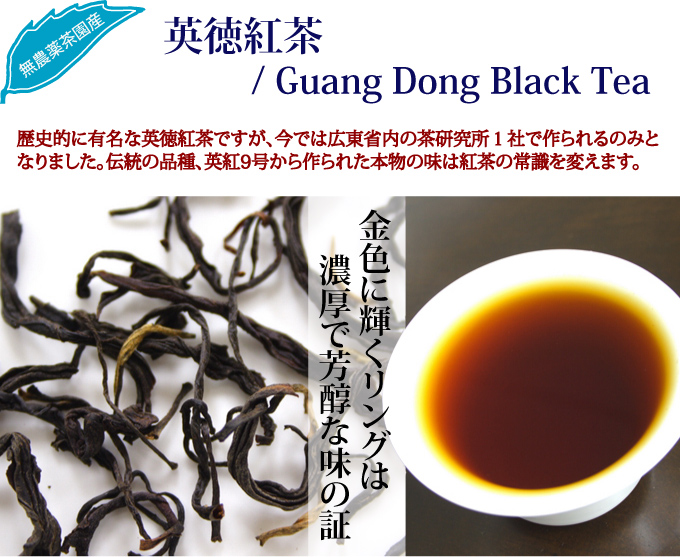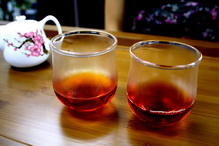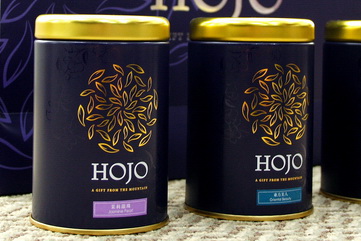
Thank you for visiting HOJO website. If you have any enquiry, please feel free to get in touch with us at
▼ Akira Hojo
▼ Hojo Newsletter
▼ HOJO FACEBOOK





HOME > Black Tea >Guang Dong Black Tea

Have you ever heard of the “Golden Ring”?
When serving Guang Dong Black Tea in a white tea cup, you will observe a golden ring near the edge of tea. However, this golden ring does not appear for any black tea. Only well-made black tea contains the yellow pigment called TF (theaflavin). If the black tea contains sufficient amount of TF, the golden ring will appear. This substance gives a very mellow and sweet after taste. On the other hand, tea that is not well-processed contains TA that gives an astringency and flat taste. For black tea, the amount of TF in the tea is an indicator of its quality; it is important to have more TF than TA. Theaflavin (TF) are formed in the tea leaves during the enzymatic oxidation (in tea line, it is referring to as fermentation) of tea leaves.

This tea gives a very long lasting after taste and lingering sweetness. Moreover the tea never tastes bitter no matter how long it is brewed. It tastes good even added with milk. It is also a good compliment with dessert, like cakes, and etc.
Take a look at the brewed tea leaves. It is made of very big tea leaves, yet it is tender and can even stick to the finger. The brewed tea leaves are brownish red color and its color is very consistent. Usually inferior black tea leaves shows 2 tones of color.
Guang Dong Black Tea comes from Guang Dong Province in China. There are a very limited number of manufacturers who are involved in making this tea. The genuine Guang Dong Black Tea must be made of the cultivar called Ying Hong No.9 that gives a very sweet and thick taste. Our Guang Dong Black Tea is manufactured by Guang Dong Tea Institute. The tea is free from pesticide.
The characteristic of Guang Dong Black Tea changed when it is kept for many years. Although the strength of flavor remains the same, the type of flavor changes during the storage period. Usually we will keep it for more than 1 year in order to get it well matured so as to enjoy a dry-fruity flavor.



Guang Dong Black Tea is a very rare type of black tea. Long ago, it was a very popular tea. But now, only a very limited number of tea manufacturers remain. Moreover there are too many counterfeits in the market. Some of them even consist of tea leaves that appear gold in color. The genuine quality is made of a specific cultivar called Ying Hong No.9, which is cultivated from Yunnan big leaf cultivar (Assam species) by the tea research institute in Guang Dong Province.
Guang Dong Black Tea gives a subtle sweet aroma, like honey. The taste of this tea is mellow, thick and long lasting on your throat. Unlike to the commercial black tea, Guang Dong Black Tea does not give a bitterness taste and astringency. No matter how long it is brewed, it maintains its smoothness and mellowness.
This tea is also second to none when you look for milk tea. Since originally this tea is very smooth, when it is combined with milk, the taste is unimaginably smooth; it gives a very silky feeling meandering down the throat.
This tea is also a great partner with cake. Since tea is quite thick and with body, it is suitable to serve together with a wide range of cakes.
Guang Dong Black Tea is one of the China historical teas which is sold to the overseas market. It is produced at Ying-de City (英德市 Ying-de Shi) at Guang Dong Province (广东省 Guang-dong Sheng)
It originated from the Yunnan Big Leaf Cultivars (云南大叶种 Yun-nan Da Ye Zhong) which was planted at Guang Dong ever since 1956. After three years of research, the Guang Dong Black Tea was successfully produced. As a result of the research carried out by the tea institute, the new cultivar was bred and named as Ying Hong No. 9 (英红九号 Ying Hong Jiu-hao). Since then, it was widely planted and its product covered a full range of grading for black tea, i.e., BOP, OP, and FBOP up to fanning and tea dust. It gave a very strong honey-like flavor with thick red liquor; these distinctive cup characteristic had gained much attention. During the 19th century, great amounts of Guang Dong Black Tea were exported to European countries. The yearly production quantity had reached almost 5,000 tones from about 5500 hectare of tea garden.
In 1963, the Queen of Britain particularly selected this tea to serve Her honored guest during a royal banquet. Its strong flavor with thick and mellow taste was highly praised and renowned.
Guang Dong Black Tea has been awarded many times at international and domestic tea competitions. The main awards are:
1986: Guang Dong Black Tea BOP won the Gold Prize from the Paris Food and Travel Association. (巴黎美食旅游协会)
1991: Awarded the Gold Prize at International Expo
1992: The series of Guang Dong Black Tea products won the Silver Prize at the 92nd International Food Expo held at Hong Kong.
However, starting from the late 19th century, Guang Dong Province had undergone rapid development in the industrial sector, and agricultural products no longer remained as the main economy index. Tea product faced the same situation. Up to date, the only place in the world which produced this tea is the Tea Institute located at the Guang Dong Agriculture School of Tea at Ying-de City. It is specially treated solely for the purpose of preserving the cultivar: Ying Hong No. 9. The production is carried out during April and May. Every year, only very limited quantity is produced: about 50kg or less.
It was originated from the Yunnan Big Leaf Cultivars (云南大叶种 Yun-nan Da Ye Zhong) which was planted at Guang Dong ever since 1956. Plucking is carried out by hand. We selected the earliest plucked spring tea in order to maintain the long lasting flavor and taste.
· Shape of dry leaf: Leaf is thick, robust, tightly rolled taut strips.
· Color of dry leaf: Leaf in dark black in color and looks glossy and lustrous.
· Aroma: Dry leaf gives a mild sugar syrup flavor with a flowery scent. When brewed, the liquor gives the same aromatic profile.
· Color of liquor: When brewed, the tea produces liquor with a thick red color, with is lustrous and bright. One of the distinctive criteria of Guang Dong Black Tea is it gives a very bright golden ring appearing near the edge of liquor to the cup. The presence of the golden ring indicates that the tea leaves are rich in theaflavins that is vital for good quality. When added with milk, the bright golden brown color remains.
· Taste: Smooth and thick. The taste lingers on the tongue and mouth, and gives a refreshing note with a mild sweet after taste.
· Brewed leaf: The brewed leaves show a bright brownish red color, very consistent and even over the leaf, indicating good quality and well-made tea. When touched with the finger, the leaves are thick, soft and elastic. If the tea is of poor quality, leaves are a mixture of greenish brown and red color. When touched, the leaf is very thin but stiff, with very thick and coarse leaf vein. Besides, the green color spot if found on surface of the leaf indicates insufficient oxidation. The leaf looks dull and lack of brightness, and in dark color indicating inappropriate processing.

In you are using tap water, it is necessary to use a water filter that consists of activated carbon filter. Otherwise, you wouldn’t be able to enjoy the authentic taste of tea. If using commercial mineral water, it is important to choose the natural mineral water. Never use distilled water or reversed osmosis processed water. These water lack of mineral content and thus the taste of tea is too soft and a little plain. Soft water is better than hard water. Brewing tea with hard water makes it taste bitter while soft water makes it taste gentle and sweet. The softness of water is written on the mineral water bottle as TDS: total dissolved solid. You need to choose the water that TDS is below 200mg/liter.
Go to further information about suitable water for brewing tea >>
Use boiling water. It is very important to boil water so as to evaporate chlorine and other kinds of contaminated substance in water. Do not boil for more than a few minutes. Boiling too long would rather concentrate the minerals and the character of water may change to hard water.
The suitable teapot for black tea is the red clay teapot. The bone China ware also gives a good effect. But still the effect of red clay is far beyond bone china. Make sure rinse the tea pot with boiling water for about 10-20 seconds in order to warm it up. Brewing time is about 30 seconds. For 2nd brewing, please keeps the brewing time less than a few seconds.
Volume of water / 5 = Weight of tea leaf to be used.
Once brewing is completed, make sure to pour out the tea until the last drop. In addition, please leave the lid opened while waiting for the next brewing. This is important to maintain the taste of subsequent brewing and also to avoid tea leaves from being over cooked.
Once a bag of tea is opened, please finish it within 3 months if you wish to enjoy its freshness. From the medical point of view, it is safe to consume the tea even if it is kept for a few years. However the freshness disappears if it is kept for too long. Tea must be tightly sealed before it is kept. Tea should be kept in ambient and dry conditions such as in the living room, but it must be completely away from humidity. Tea should not be kept in the kitchen as the environment is very humid. Avoid enclosed area such as inside the cupboard or drawer as these places are damp. Also avoid opening the bag of tea in humid atmosphere. It is recommended to open the bag during a sunny day or under air-conditioned atmosphere. Once tea leaves absorb moisture, deterioration of tea will be triggered within a few days. Tea will then give an astringent taste, sometime it tastes sour. The fresh aroma also becomes weaker.
The quality of tea lasts longer if it is kept in the fridge. However we strongly recommend you not to keep tea in the fridge. When tea is withdrawn from the fridge, there is usually condensation. Once tea is exposed to moisture during condensation, the quality will deteriorate within a few days. The higher moisture content in the tea leaves will trigger oxidation and it will completely destroy the quality of tea.
Here’s another frequently asked question: what happens if bag is sealed using tape or tea is packed in a zipper bag and kept inside the fridge?
For your information, these simple sealing methods are not sufficient. When the bag is withdrawn from the fridge, it is cold inside the bag and therefore causes negative pressure. Air will be drawn from outside and condensation will occur. In addition, if the bag is taken in and out from the fridge very often, this will cause heat stress to the tea leaves as temperature is increased and decreased very frequently. If tea is kept in the fridge, when it is withdrawn from the fridge, it is necessary to leave it in ambient atmosphere for more than 24 hours in order to warm up the tea leaves. Based on our experience, 12 hours is not long enough. We may think tea is warmed up, but inside the bag, the tea leaves are still cold due to insulation effect.
You can also enjoy the changes of taste and aroma of tea caused by the maturation. When the tea is stored in ambient atmosphere for a few years, tea gets matured and changes its character. Tea lost refreshing aroma like flowery scent or fresh fruity note, instead, it gives more matured and sweet aroma. It is hard to conclude which is better between the fresh and matured tea. It is depend on individual preference. In general, elderly people prefer a more matured taste of tea.

Please feel free to send us e-mail for enquiry at:

 |
We accept various kinds of credit card through Paypal.
Only if customer prefer other option of payment, we suggest "Bank Transfer".
Various choice of shipping method
EMS, SAL, Small Packet, Small Packet (SAL) Yamato Express and Surface
For shipping tea, we usually suggest small air parcel, the estimated shipping cost of tea in 100g (with wrapping material ) is
Small Parcel
USA JPY 600, EU JPY600 and Asia JPY470
Small Packet (SAL)
USA JPY380, EU JPY380 and Asia JPY320
The shipping fee to oversea by small air parcel happens to be even cheaper than domestic shipping fee in Japan.
For your information, some countries, EU in particular imposes custom duty. We need buyer to bare the duty. We are sorry, but we cannot change the amount on the invoice, and we do not mark any packages as gifts. We will strictly follow the custom regulation.